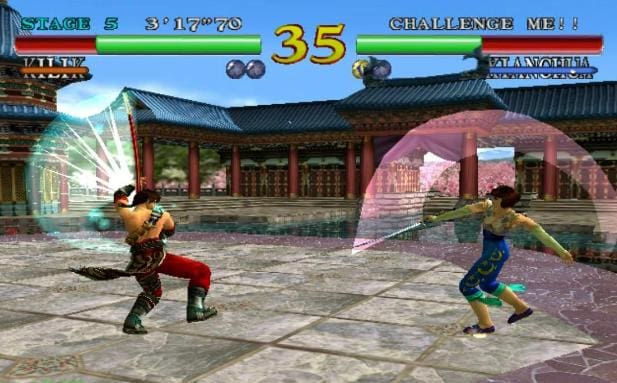“Soulcalibur” is a popular fighting game developed and published by Namco (now Bandai Namco Entertainment). It was released in arcades in 1998 and later made available on the Sega Dreamcast console in 1999. Considered one of the greatest fighting games of its time, “Soulcalibur” is the second installment in the “Soul” series and a direct sequel to “Soul Edge.”
Set in a fictional 16th-century world, “Soulcalibur” revolves around the quest for the legendary weapon called Soul Edge, a cursed sword with immense power. Players take control of various warriors, each with their own unique fighting style and motivations, as they engage in one-on-one battles in a quest to obtain or destroy Soul Edge.
Soulcalibur Facts
- “Soulcalibur” is the second installment in the “Soul” series, originally known as “Soul Edge” in Japan.
- The game was developed and published by Namco (now Bandai Namco Entertainment) and was released in arcades in 1998.
- “Soulcalibur” was known for its impressive graphics and animation, showcasing the capabilities of the arcade hardware at the time.
- The game was widely acclaimed for its deep and accessible gameplay, striking a balance between casual and competitive players.
- “Soulcalibur” introduced the iconic weapon-based combat system that would become a defining characteristic of the series.
- The roster of playable characters in “Soulcalibur” included a diverse range of warriors, each with their own unique fighting style and backstory.
- The game introduced the 8-way run movement system, allowing characters to freely move in any direction around the 3D arenas.
- “Soulcalibur” featured a variety of gameplay modes, including arcade mode, versus mode, time attack, survival, and mission mode.
- The “Edge Master” mode in the game challenged players to complete a series of battles with different conditions and rules.
- The original arcade version of “Soulcalibur” included hidden characters, such as Cervantes and Sophitia’s sister, Cassandra.
- “Soulcalibur” received numerous accolades, including multiple “Game of the Year” awards and high praise from both critics and players.
- The success of “Soulcalibur” led to the development of several sequels, spin-offs, and crossovers with other game franchises.
- The “Soulcalibur” series is known for its guest characters from other popular franchises, including Link from “The Legend of Zelda” and Geralt of Rivia from “The Witcher” in later installments.
- The game’s soundtrack, composed by Junichi Nakatsuru and others, received widespread acclaim for its memorable and epic themes.
- “Soulcalibur” had a significant impact on the fighting game genre, influencing subsequent titles with its weapon-based combat, deep mechanics, and accessible gameplay.

Soulcalibur (1998) game controls
Basic Controls:
- D-Pad: Move your character.
- A Button: Horizontal attack.
- B Button: Vertical attack.
- X Button: Kick.
- Y Button: Guard.
- L Button: Guard Impact (Parry).
- R Button: G (Gauge) Cancel.
- Start Button: Pause the game.
Advanced Controls:
- Guard Impact: Guard + Forward + Y Button.
- Throw: Forward + Y Button.
- Critical Edge: Guard + Forward + A + B + K.
- Sidestep: Tap Up or Down quickly.
- Backstep: Tap Away from the opponent quickly.
- G (Gauge) Attack: Press A + B + K when the gauge is full.
- G (Gauge) Defense: Press Guard + A + B + K when attacked with a G (Gauge) Attack.
Soulcalibur Gameplay Tips
- Master the Basics: Familiarize yourself with the basic controls, such as movement, blocking, attacking, and guarding. Practice executing various attacks, including high, mid, and low strikes.
- Learn Your Character: Choose a character whose fighting style resonates with you and invest time in understanding their move set, strengths, and weaknesses. Each character has unique abilities and playstyles, so find one that suits your preferences.
- Block and Guard Impact: Blocking is essential in “Soulcalibur” to defend against incoming attacks. Mastering the Guard Impact technique, which allows you to parry enemy strikes and create openings, can turn the tide of battle in your favor.
- Utilize Vertical and Horizontal Attacks: Experiment with both vertical (up or down) and horizontal (left or right) attacks. Vertical strikes are effective against opponents who crouch or sidestep, while horizontal strikes can catch opponents off-guard.
- Combine Attacks into Combos: Practice stringing together different attacks to create combos. Combos can deal significant damage and provide momentum in battle. Experiment with timing and input sequences to maximize your combo potential.
- Learn to Side Step: Mastering sidestepping can give you an advantage by evading attacks and creating openings for counterattacks. Combine sidesteps with quick strikes to catch opponents off-guard.
- Exploit Ring Outs: Take advantage of the ring-out mechanic by positioning your opponent near the edge of the stage. Well-timed attacks or guard impacts can knock them out of the ring, instantly securing a victory.
- Manage Your Guard Gauge: Pay attention to your Guard Gauge, which depletes when blocking attacks. If the gauge empties completely, your guard will break, leaving you vulnerable. Use Guard Impacts strategically to avoid reaching that point.
- Practice Step Guarding: Step Guarding is a technique that allows you to move while blocking. It can help you maintain a strong defense while still staying mobile and ready to counterattack.
- Study Opponent Patterns: Pay attention to your opponent’s habits and patterns. Look for openings, weaknesses, and predict their next moves. Adapt your strategies and playstyle accordingly.
- Master Critical Edge and Soul Charge: Critical Edge is a powerful super move that can turn the tide of battle. Use it strategically when you have an opportunity. Soul Charge, on the other hand, can enhance your character’s abilities temporarily, providing various benefits.
- Be Mindful of Range: Different characters and attacks have different ranges. Understand your character’s optimal range and adjust your positioning accordingly to maximize your effectiveness.
- Utilize Guard Break Attacks: Some characters have special attacks that can break an opponent’s guard. These moves can be effective in breaking through a defensive opponent and creating opportunities for follow-up attacks.
